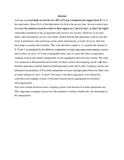Turning Adversity Into Opportunity: Can Pigeonpea Do It?

View/
Date
2011Author
Kwena, K.M
Karanja, N
Gachene, C.C.K
Esilaba, A.O
Vanlauwe, B
Type
PresentationLanguage
enMetadata
Show full item recordAbstract
Arid and semi-arid lands account for over 80% of Kenya’s landmass and support about 35-% of
her population. About 65-% of the inhabitants live below the poverty line. Several workers have
described the situation currently evident in these regions as a “poverty trap”, in which the highly
subsistence population living on degraded soils receives low income, afford low or no farm
inputs, and consequently get low crop yields. Studies indicate that pigeonpea could reverse this
trend. It ameliorates soils and boosts cereal yields tremendously. Locally, however, little has
been done to quantify these benefits. This study therefore sought to: (1) quantify the amount of
N, P and C accumulated by the different components of maize-pigeonpea intercropping systems
and its effect on soil C, N, P and exchangeable bases, and (2) assess the effect of pigeonpea
cropping systems and residue management on soil aggregation and soil water content. The study
was conducted at Katumani Research Centre for three seasons. Intercropping cereals with short
duration pigeonpea varieties depressed both pigeonpea grain and N yield. Cropping systems also
influenced accumulation of P in yield components of maize and pigeonpea. However, there were
no major changes in soil C, N and P. Soil macro- and micro-aggregates were affected by
cultivation and cropping systems. Cultivation reduced macro-aggregation but increased microaggregation.
Soil water content increased across cropping systems with increase in residue
application rate. Thus, pigeonpea cropping systems have the potential to enrich or deplete the
soil, depending on the management.
